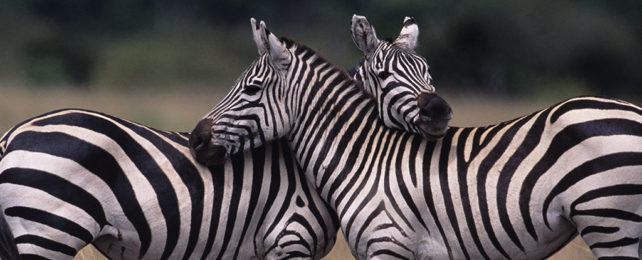In what once seemed like a pretty black and white case of camouflage, the explanation for the zebra's striking pattern now seems to have more to do with keeping blood-sucking flies at bay.
As scientists grow increasingly confident in why zebras are striped, they are now turning their attention to how it works. A new study thinks it has found at least part of the answer, once again the help of some eye-catching black-and-white patterned blankets and a few patient accomplices.
Several years ago a study led by researchers from the University of Bristol in the UK found zebra stripes were a reasonably good guard against biting flies.
By putting blankets of different designs on the backs of horses, and then filming the behavior of horse flies as they approached and interacted with the horses, the scientists were able to see the effects of various stripe and checkerboard designs.
Now members of the same team are using a similar method to better understand exactly what it is about the stripes pests hate.
"We knew that horse flies are averse to landing on striped objects," says evolutionary ecologist Tim Caro from the University of Bristol in the UK. "A number of studies have now shown this, but it is not clear which aspects of stripes they find aversive."
"Is it the thinness of the stripes? The contrast of black and white? The polarized signal that can be given off objects? So we set out to explore these issues using different patterned cloths draped over horses and filmed incoming horse flies."
While the horse flies were most attracted to large dark objects in their environment – with all-gray blankets resulting in the most landings – once the dark color is broken up with some white, the flies become less keen to interact.
Coats with large black triangles placed in different positions were shown to be the next most popular design amongst flies, followed by coats with small checkerboard patterns. Stripes were the most off-putting for flies, with higher contrast stripes attracting the fewest fly landings during tests.
The researchers think the key is eliminating the strong outline of a large dark patch in the field of view of horse flies, something which stark black and white stripes do rather well. In other words, it means zebras look like less of a target.

"This suggests that any hoofed animal that reduces its overall dark outline against the sky will benefit in terms of reduced ectoparasite attack," says Caro.
Based on the findings of this study, the flies aren't being put off by any kind of optical illusion effect or by light polarization (certain parts of the zebra appearing brighter). The pattern of thin stripes that acts as a kind of camouflage after all; not against large predators, but tiny ones.
Scientists have been trying to figure out the purpose of the zebra's stripes for years – it's previously been suggested that they're some kind of temperature control mechanism or a way of confusing approaching horse flies.
The next question up for debate is why are zebras the only hoofed mammals we know of to have evolved this special design on their bodies. That's something that can be looked at in the future.
"We know that zebra pelage – fur – is short, enabling horsefly mouthparts to reach the skin and blood capillaries below, which may make them particularly susceptible to fly annoyance," says Caro.
"More important, perhaps, is that the diseases that they carry are fatal to the horse family but less so to ungulates. This needs investigation."
The research has been published in the Journal of Experimental Biology.
